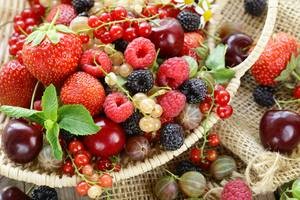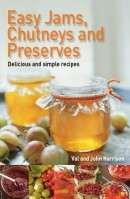 Fruit
Fruit
Choose fruit which is dry, sound and not over ripe. Fruit which is wet or damaged can cause the jam to go moldy and over ripe fruit lacks pectin and acid so the jam will not set properly
The fruit should be thoroughly softened by simmering to extract the pectin which, when boiled with sugar, will cause the jam to set. If the sugar is added before the fruit is properly cooked, the jam will not set, the skin of the fruit becomes tough and the jam is often a dark colour.
To obtain jam that will set properly, it is necessary to extract the pectin by simmering the fruit and the acid naturally contained in the fruit will assist the pectin extraction.
Frozen fruit can be used but allow 10% more fruit to sugar to make up for the loss of pectin caused through freezing or add additional pectin if you prefer.
Acid
To set properly, your jam needs the correct proportions of acid, pectin and sugar. Acid also affects the colour of the final jam, making it brighter and cuts the sweetness so the jam tastes more of the fruit than sugar. Some fruits are naturally high in acid but others are low so we need to compensate for this by adding acid at the start before we start cooking.
The recipes will tell you how much acid you need to add, usually in the form of lemon juice. This can be either fresh lemons or you many find it more convenient to keep a bottle of lemon juice in the cupboard. 2 tablespoons of lemon juice is the equivalent to the juice of one lemon.
You can substitute for lemon juice by dissolving one level teaspoon of tartaric acid or citric acid powder in half a teacup of water for each lemon.
Sugar Types for Jam Making
Theoretically you can use any type of sugar and even honey to make a jam. In practice brown sugars will end up with a very dark coloured jam and honey is too good to jam. Any type of white sugar may be used but it will dissolve more quickly if warmed in the oven along with sterilising jars prior to adding to the fruit juice.
To warm the sugar, put into a cool oven, Gas Mark 1 (140°C/275°F), for a few minutes before adding to the fruit.
Preserving Sugar
Preserving sugar dissolves well and creates less scum but the amount of scum can be reduced considerably by adding a knob of butter or a few drops of glycerine during the cooking process.
The sugar must dissolve in the simmered fruit before it is brought to the boil, otherwise the jam may become crystallised and sugary.
Jam Sugar
Jam sugar is just sugar with added pectin – do not confuse with preserving sugar that has no added pectin. We generally just use ordinary white sugar and shop around for the cheapest we can find, adding pectin as required.
NB Sugar is used in jam for its preserving qualities and you can not substitute sweeteners like ‘Splenda’ or ‘Sweet’n’low’ for sugar in jam.
Amount of Sugar
Most recipes for fruit with a moderate amount of pectin call for an equal amount of sugar to fruit. However, in theory, the best setting and keeping qualities are obtained with a jam containing 60% of sugar and fruit which is high in pectin, eg gooseberries and blackcurrants, can have up to 1½ times volume of sugar to fruit.
Personally, we’ve never found any problem in setting or storing high pectin fruit jams and no improvement to the flavour by adding the extra sugar so mainly use the 50/50 combination. However, when using a fruit that is low in pectin, eg cherries, it is advisable to increase the proportion of fruit to sugar to allow more pectin to be extracted.
The same applies when using frozen fruit, allow 10% more fruit to sugar to compensate for the loss of pectin caused by freezing. Alternatively, add more pectin stock or powder.
Water
Fruits that need very little water (just enough to prevent burning on the pan base) or none at all include the juicy berries, strawberries, raspberries, elderberries etc.
Stiff textured fruits such as plums, greengages, rhubarb and apples will need about half the volume of the fruit adding as water.
For the citrus fruits, oranges, lemons, grapefruit and limes, you need between twice and three times the volume of fruit as water.
Very hard waters and water with a chemical taste can effect jams and it may well be worth filtering.
More in Jams, Jellies & Marmalades
- Jam and Jelly Making Method
- Equipment Required for Jam and Jelly Making
- How to Make Marmalade
- Pectin – How to Test for Pectin
- Pectin for Jam, Jelly & Marmalade Making
- Making Jams in Microwave & Bread Machines etc.


